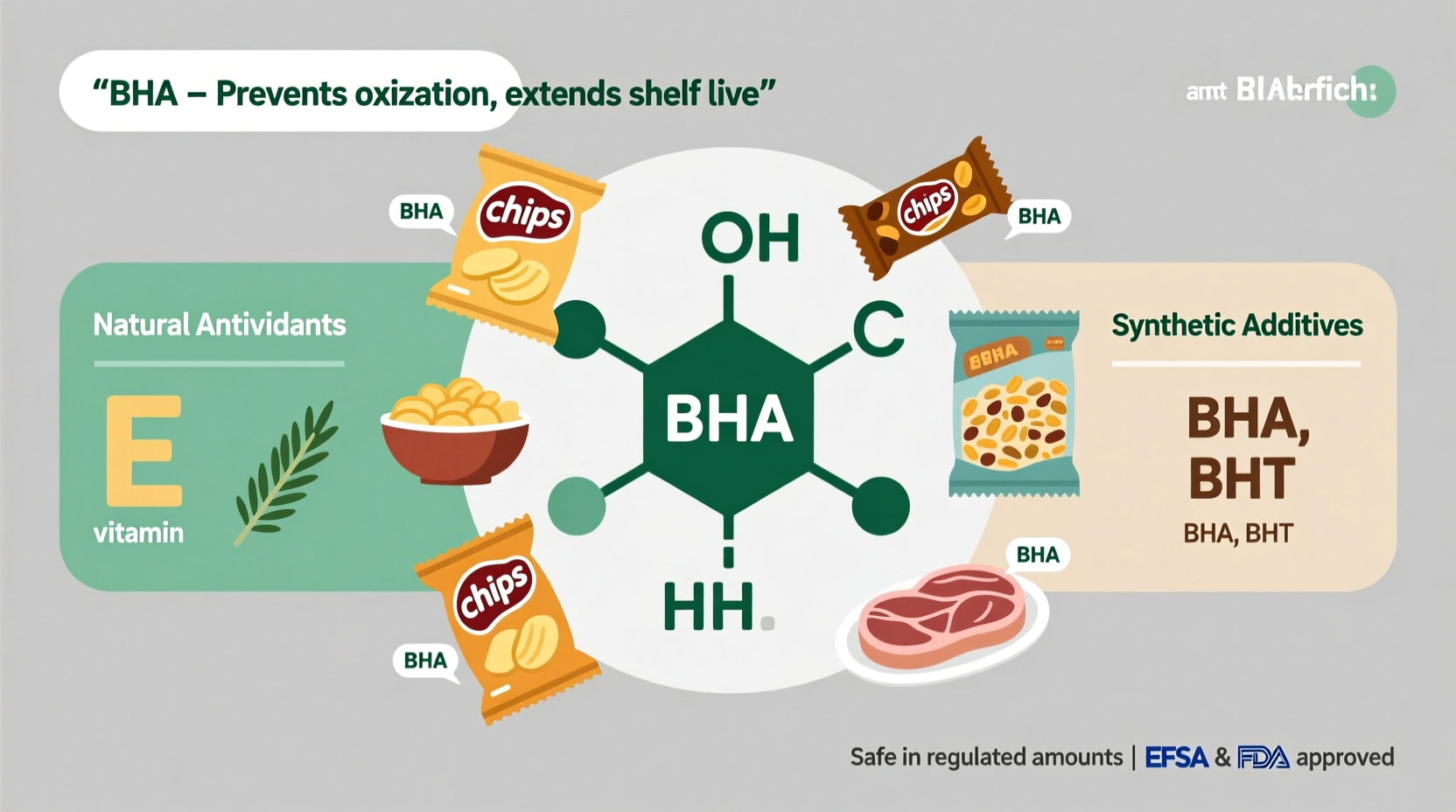When you scan ingredient lists on your favorite snacks, you've likely encountered the mysterious acronym BHA. Understanding this common food additive empowers you to make informed choices about what you consume. This comprehensive guide cuts through the confusion with science-backed facts about BHA's role in food preservation, regulatory status, and what current research reveals about its safety profile.
What Exactly Is BHA in Food Chemistry Terms?
BHA (butylated hydroxyanisole) is a synthetic phenolic compound created through chemical synthesis of 4-methoxyphenol and isobutylene. As an antioxidant, it functions by donating hydrogen atoms to free radicals produced during lipid oxidation, effectively interrupting the chain reaction that causes fats and oils to become rancid. Its molecular formula (C11H16O2) enables stability at high temperatures, making it particularly valuable for fried and baked goods.

Why Food Manufacturers Use BHA: The Preservation Science
Food scientists rely on BHA for three critical preservation functions:
- Rancidity prevention - Extends shelf life of fatty foods by up to 50% compared to unprotected products
- Color retention - Maintains appealing appearance in processed meats and snacks
- Vitamin preservation - Protects fat-soluble vitamins (A, D, E, K) from degradation
Without antioxidants like BHA, many packaged foods would develop off-flavors and potentially harmful oxidation products within weeks. The food industry typically uses BHA in combination with BHT (butylated hydroxytoluene) for synergistic protection, with concentrations carefully calibrated to remain below the FDA's 0.02% maximum limit for fats and oils.
Where You'll Find BHA: Common Food Applications
This preservative appears in approximately 3,500+ food products currently on US market shelves. The most prevalent applications include:
| Food Category | Common Products | Typical BHA Concentration |
|---|---|---|
| Snack Foods | Chips, crackers, popcorn | 0.01-0.02% |
| Baked Goods | Cookies, cake mixes, frosting | 0.005-0.015% |
| Processed Meats | Sausages, bacon, dried meats | 0.01-0.02% |
| Fats & Oils | Vegetable oils, shortening, margarine | 0.02% maximum |
| Breakfast Items | Cereals, instant potatoes | 0.005-0.01% |
Regulatory Status: How Different Countries View BHA Safety
Global regulatory agencies have established varying positions on BHA usage based on decades of scientific review:
- United States (FDA) - Maintains BHA's GRAS (Generally Recognized As Safe) status since 1947, with current regulations permitting up to 0.02% in fats and oils (21 CFR §172.110). The FDA's Center for Food Safety and Applied Nutrition continues to monitor research through its Food Additive Status List.
- European Union (EFSA) - Authorizes BHA (E320) with an ADI (Acceptable Daily Intake) of 0.5 mg/kg body weight, though some member states like Romania have implemented stricter national limits. The European Commission's 2019 re-evaluation confirmed current usage levels as acceptable.
- Japan - Permits BHA with strict concentration limits (0.02% in fats, 0.002% in chewing gum) and requires clear labeling per the Food Sanitation Law.
- Canada - Allows BHA under the Food and Drug Regulations (Schedule B), with maximum levels varying by food category.
The World Health Organization's Joint FAO/WHO Expert Committee on Food Additives (JECFA) established an ADI of 0-0.5 mg/kg body weight in 2016 after reviewing over 100 scientific studies, noting that typical dietary exposure remains well below this threshold for most consumers.
Scientific Research: What Studies Reveal About BHA Safety
Understanding BHA requires examining the complete scientific picture rather than isolated studies. Key research findings include:
- Cancer research - The National Toxicology Program's 1986 study showed tumor formation in laboratory rats at extremely high doses (equivalent to hundreds of grams daily for humans), but subsequent research by the European Food Safety Authority found no evidence of carcinogenicity at permitted usage levels.
- Metabolic effects - A 2020 review in Food and Chemical Toxicology concluded that BHA demonstrates minimal endocrine disruption potential compared to other phenolic compounds, with effects only observed at concentrations far exceeding realistic dietary exposure.
- Human studies - Population research published in the American Journal of Clinical Nutrition (2022) tracking 12,000 adults over 10 years found no significant health outcomes associated with typical BHA consumption within regulatory limits.
The scientific consensus, as reflected in the FDA's ongoing monitoring and EFSA's periodic re-evaluations, maintains that BHA is safe for human consumption at current regulated levels. However, researchers continue to investigate potential effects at the molecular level, particularly regarding individual genetic variations in metabolism.
Reading Labels: How to Identify BHA in Your Food
When checking ingredient lists, look for these identifiers:
- "Butylated Hydroxyanisole" (full chemical name)
- "BHA" (most common abbreviation)
- "E320" (European food additive code)
Manufacturers must list BHA in the ingredients statement when used at 0.1% or more. In the European Union, products containing BHA must include the statement "may have an adverse effect on activity and attention in children" when used with certain other preservatives.
Practical Guidance for Consumers
Based on current scientific understanding, here's how to approach BHA in your diet:
- For most consumers - No need for concern at typical exposure levels. The average American consumes approximately 0.1 mg/kg body weight daily, well below the 0.5 mg/kg ADI established by international authorities.
- For parents - While research doesn't indicate specific risks for children, those following precautionary approaches may choose products labeled "preservative-free" for children's snacks.
- For sensitive individuals - Rare cases of BHA sensitivity have been documented. If you suspect a reaction, consult a healthcare provider and consider an elimination diet under professional supervision.
- Reading labels - Focus on overall product quality rather than isolated ingredients. Products containing BHA often have longer ingredient lists with multiple processed components.
Natural Alternatives to BHA
Food manufacturers increasingly offer products using alternative preservation methods:
- Vitamin E (tocopherols) - Effective natural antioxidant, though less stable at high temperatures
- Rosemary extract - Gaining popularity for its potent antioxidant properties
- Ascorbic acid (vitamin C) - Works synergistically with other antioxidants
- Modified atmosphere packaging - Physical method reducing oxygen exposure
These alternatives often require higher concentrations and may affect product taste or appearance, explaining why many manufacturers continue using BHA for certain applications where performance is critical.
Conclusion: Making Informed Choices About BHA
BHA remains one of the most thoroughly studied food additives with a 75+ year safety record when used within regulatory limits. While no food additive is completely without controversy, the overwhelming scientific consensus supports its safety at current usage levels. Rather than focusing on single ingredients, nutrition experts recommend considering your overall dietary pattern - a balanced diet rich in whole foods naturally limits exposure to all processed food additives. When choosing packaged foods, prioritize products with shorter ingredient lists and recognizable components, whether they contain BHA or not.











 浙公网安备
33010002000092号
浙公网安备
33010002000092号 浙B2-20120091-4
浙B2-20120091-4